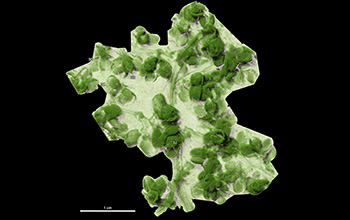Multimedia Gallery
3D CT scan of a fossilized spurge plant
This 3D CT scan of a 52-million-year-old fossilized spurge plant discovered in Argentina shows fruits and the tiny paired seeds inside them. A study suggests that the spurge family's Macaranga-Mallotus clade, encompassing a common ancestor and all its descendants and long considered to have Asian origins, may have first appeared in South America when it was still part of Gondwana -- the supercontinent that encompassed South America, Antarctica and Australia -- before moving around the globe.
[Research supported by U.S. National Science Foundation grants DEB 1556666, DEB 1556136, EAR 1925755 and EAR 1925552.]
Learn more in the Pennsylvania State University news story Spurge purge: Plant fossils reveal ancient South America-to-Asia 'escape route'. (Date of image: 2023; date originally posted to NSF Multimedia Gallery: Aug 18, 2023)
Credit: Peter Wilf/Pennsylvania State University
Images and other media in the National Science Foundation Multimedia Gallery are available for use in print and electronic material by NSF employees, members of the media, university staff, teachers and the general public. All media in the gallery are intended for personal, educational and nonprofit/non-commercial use only.
Images credited to the National Science Foundation, a federal agency, are in the public domain. The images were created by employees of the United States Government as part of their official duties or prepared by contractors as "works for hire" for NSF. You may freely use NSF-credited images and, at your discretion, credit NSF with a "Courtesy: National Science Foundation" notation.
Additional information about general usage can be found in Conditions.
Also Available:
Download the high-resolution JPG version of the image. (1.6 MB)
Use your mouse to right-click (Mac users may need to Ctrl-click) the link above and choose the option that will save the file or target to your computer.



